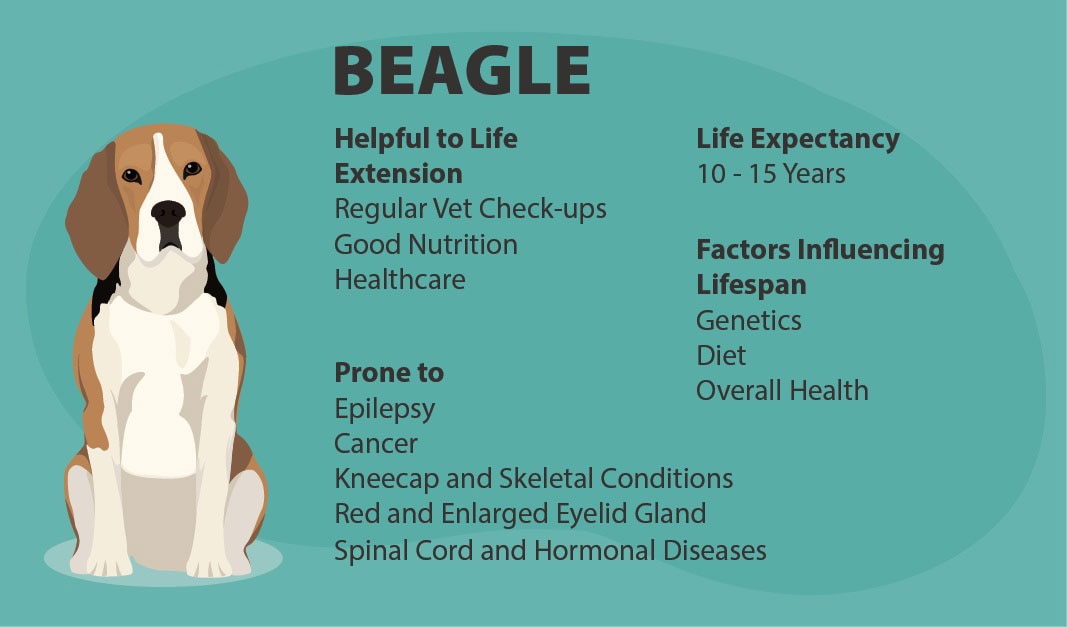With their sweet faces and dispositions, beagles may be the most lovable member of the hound group. According to the American Kennel Club (AKC), they’re certainly the most popular.1 These super-sniffers were bred to hunt, but they also make great family pets.2
Here’s what you need to know if you’re thinking about getting a beagle, including their temperament, maintenance and health and wellness needs.
About the Beagle
The beagle’s origins are shrouded in mystery and conjecture. What’s known is that small hounds employed in rabbit hunting were believed to have already been in England when the Roman Empire arrived there in 55 B.C. By A.D. 1500, it was common for English gentlemen to keep packs of these dogs for their hunts. These dogs were the forebears of the modern-day beagle.1
Because beagles were useful for hunting and tracking small game without people needing to be on horseback, their fame spread beyond the gentry to the lower classes throughout Europe. They arrived in the United States shortly after the end of the Civil War, and American rabbit hunters immediately took a shine to them.1
The AKC recognized this breed in 1885 when a beagle named Blunder was the first to be registered. Since then, the beagle has remained popular as both a hunting partner and family companion.1
Beagle Appearance

Beagles are a small to medium breed in the scent hound group. The AKC recognizes two beagle varieties based on size. The smaller variety stands up to 13 inches at the shoulder and weighs up to 20 pounds. The larger stands between 13 and 15 inches and weighs 20 to 30 pounds.1
While the heights of male and female beagles are typically the same, their weights vary slightly — between 22 and 24 pounds for males and 20 and 22 pounds for females.3 They have a deep chest and a short, straight back with a tail of about equal length, carried jauntily upright with a slight curve.4
The beagle has a slightly domed head with a straight, medium-length muzzle and big, floppy ears set low on each side of the head.4 Its most endearing physical feature is its face, with its big, brown puppy-dog eyes and an expression that’s described as “gentle and pleading.”1
The double coat is smooth, dense and of medium length.4 The breed standard allows for “any true hound color.”4 Beagles may be either tricolor or bicolor — usually white with red, tan, brown, black, blue, lemon or any combination thereof.1
Beagle Temperament
Three words used to describe the beagle are lovable, funny and happy-go-lucky. These are very loyal, loving and sociable dogs who were bred to run in packs, which means they’re happiest when they have company. Beagles aren’t loners who can be left alone for long hours, and they’ll fit right in with a large family or a home with other pets.1
Beagles are intelligent and curious. As scent hounds, they do most of their exploring with their noses, which can get them into trouble if they’re not reined in. They also have a lot of energy, and if they’re not employed with hunting, they need plenty of exercise and playtime to burn it off.1
These clever dogs are relatively easy to train, though they can be a bit willful. They respond best to food-based rewards and positive reinforcement. Trainers may need to get creative to make training more interesting than all those enticing smells the beagle’s super snoot longs to investigate. But training and socialization from an early age will go a long way toward preventing behavior problems and setting your beagle up for success.1
Living With Beagles
As sweet and endearing as beagles are, they’re also highly driven and energetic, and may not be a good fit for everyone. Learn more about what's involved in caring for beagles, along with tips to help them stay safe, happy and healthy.
Who they're best for
Beagles are pack dogs who don’t do well with being left alone for long. They need a home in which someone — either a human or another dog — will be there throughout the day to keep them company so they don’t become destructive.1
These are also energetic pups that need an owner who can take them on long, leashed walks and engage them in energetic play throughout the day. These clever escape artists aren’t dogs who can simply be let out into a yard and left on their own for exercise.2
While beagles love children and make wonderful family dogs, beagle puppies can be a lot to handle. It’s generally recommended that families with babies and small children consider getting a beagle already past puppyhood — otherwise, it will be like adding another toddler to your family. That said, a puppy can be a wonderful addition to a household with kids who are old enough to participate in a puppy’s care and training.2
Living space
The ideal home for a beagle will have a sturdy fence that’s at least 5 feet tall and reinforced around the bottom to prevent digging underneath. Even so, beagles are determined escape artists when they lock onto a scent, so they need to be supervised when outdoors.2
Beagles can thrive in apartments and homes without a fenced yard, provided they’re walked enough. But prospective beagle parents who can’t provide a fence should be aware that this means lacing up your sneakers and hitting the pavement for long walks two or three times a day.2
Exercise and activity
Beagles need at least an hour of exercise each day.1 Besides walking, hikes, fieldwork and dog sports are also excellent outlets for their energy.
Grooming
The beagle’s double coat grows thicker throughout the winter and goes through a heavy shedding season in the spring. Daily brushing can help at the height of shedding. Otherwise, they’re moderate shedders who need weekly brushing to remove loose hair and keep their coats healthy.1
Beagles don't develop a doggie odor like a lot of dogs do, so they don’t need to be bathed unless they get messy. This is a floppy-eared breed, so it’s a good idea to check their ears regularly for signs of an ear infection. Keep their nails trimmed, and brush their teeth at least a few times a week to help keep their teeth healthy between dental exams.1
Beagle Health and Life Expectancy

The average life expectancy of a beagle is between 10 and 15 years.1 Many different factors help determine an individual dog’s lifespan, including their genetics, diet and overall health. Regular veterinary checkups and good nutrition and healthcare may help extend the life of a beagle.
Beagles typically do well on a high-quality dog food that’s appropriate to their current life stage.1 Look for food with a nutritional profile that’s approved by the Association of American Feed Control Officials (AAFCO).7
Some beagles are prone to weight gain.1 Measuring their food according to the directions on the package and avoiding table scraps or too many treats can help keep them at a healthy weight.1 Replacing calorie-laden treats with fruits and veggies that are safe for dogs can also help.
Despite these preventive measures, beagles can still face specific health challenges inherent to their breed. Although reputable breeders do their best to screen for and weed out genetic disorders, prospective and current owners should be aware of these potential health issues.
Hip dysplasia
Hip dysplasia is a painful condition that prevents the hip bone from fitting properly into the hip socket. It's most common to large breed dogs, although smaller breeds can also be affected. It may be treatable with surgery or nutrition and lifestyle changes.8
Patellar luxation
In this condition that affects smaller dogs, the kneecap on one or both back legs is prone to dislocating. Mild cases can usually be managed through anti-inflammatory medications and exercise restriction. More severe cases may be helped with surgery.9
Intervertebral disc disease (IVDD)
IVDD is a condition in which degeneration along the spinal cord can cause a spinal disc to slip, resulting in back or neck pain, weakened limbs, and in some cases, paralysis. It can usually be corrected with surgery, although in severe cases, a dog may not have fully restored mobility.10
Hypothyroidism
Hypothyroidism occurs when the thyroid gland doesn’t produce enough thyroid hormone, which can wreak havoc on the metabolic system. Symptoms include lethargy, weight gain, a dull coat and sensitivity to cold. But as with humans, this condition is manageable with thyroid medication and regular checkups.11
Epilepsy
Epilepsy is a disorder in which abnormal brain function causes seizures. The cause is usually unknown, but beagles are one of many breeds in which this is a heritable condition. Seizures may be general, affecting the entire body, or focal, resulting in behavioral tics such as biting at invisible flies. There is no cure, but it can usually be managed with medication.12
Hemangiosarcoma
Hemangiosarcoma is a cancer affecting the blood vessels of the internal organs, most commonly the liver, heart and spleen. It can also metastasize and spread to other organs. Dogs with this type of cancer are susceptible to sudden internal bleeding and death. It’s usually treated with chemotherapy and surgery, although a medical procedure may not be possible for tumors located on the heart.13
Cherry eye
Cherry eye happens when the tear duct on a dog’s inner eyelid, or nictitating membrane, prolapses and becomes red and enlarged. It’s not a threat to your dog’s vision, but it can be uncomfortable for them. It’s usually corrected with a simple surgical procedure.14
Buying or Adopting a Beagle
The average cost to purchase AKC-registered beagle puppies from a reputable breeder typically ranges between $1,000 and $2,500 or more, depending on factors including location and whether the puppy is from a championship line. The price usually includes early vaccinations, health checks and genetic testing.15
Beagles and beagle mixes of all ages are available for adoption at pet shelters and breed rescues. Adoption fees for beagles start at $180 and usually include the cost of vaccinations and spaying or neutering.16 You can find a map of reputable beagle rescue groups across the U.S. at SOS Beagle Rescue, Inc.
CareCredit Credit Card Financing for Dogs
Taking good care of your pet's well-being from nose to tail is essential. Make sure to stay up to date on their regular checkups at the vet to help keep your pet happy and healthy for a lifetime of love. You can use your CareCredit credit card for pet care throughout the year for routine veterinary services as well as emergencies and surgeries.* Use our Acceptance Locator to find a veterinarian near you that accepts CareCredit.
CareCredit is there for you and your pet every step of the way; continue your wellness journey by downloading the CareCredit Mobile App to manage your account, find a provider on the go and easily access the Well U blog for more great articles, podcasts and videos.
In addition to pet care, you can also use your CareCredit credit card for dentistry, cosmetic, vision, hearing, health systems, dermatology, pharmacy purchases, spa treatments and so much more within the CareCredit network. How will you invest in your health and wellness next?
Author Bio
Jean Marie Bauhaus is a freelance writer and novelist who has been writing pet content since 2013. Her work has appeared on Forbes.com, Hill's Pet, Chewy, AKC.org and more.







